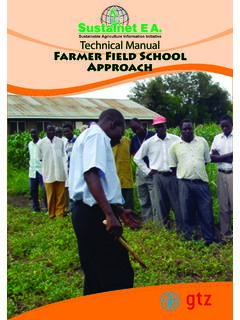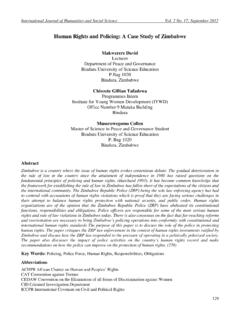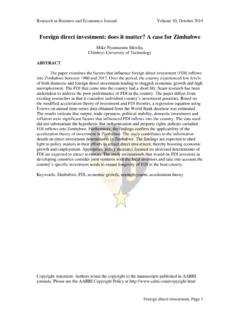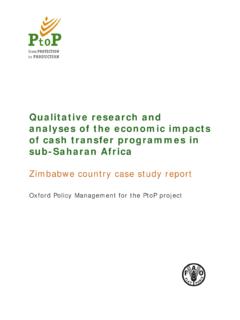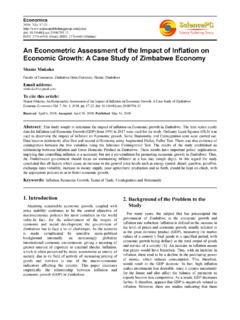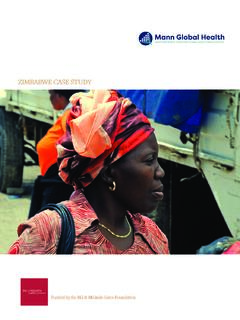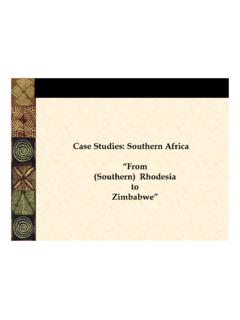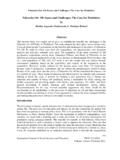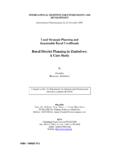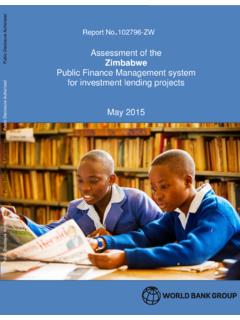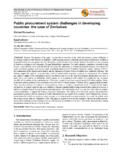Transcription of ZIMBABWE: COPING WITH DROUGHT AND CLIMATE …
1 Country zimbabwe [ ] Region Eastern Africa Key Result Area Agriculture/Food Security Disaster Risk Management Water Resources Keywords: DROUGHT , DROUGHT monitoring, Capacity Building, Livelihoods, Early Warning Systems (EWS), DROUGHT Risk Management UNDP Project ID 3785 Project Activity Dates Start: October 2007 End: December 2012 Key stakeholders Local Communities in the Chiredzi District and in particular the smallholder farmers within the Chiredzi District. zimbabwe : COPING WITH DROUGHT AND CLIMATE CHANGE zimbabwe case study DECEMBER 2010 2 zimbabwe case STUDYBRIEF DESCRIPTION OF ISSUES Background About 70% of zimbabwe s population derives its livelihood from subsistence agriculture and other rural activities, but these livelihoods are threatened by CLIMATE change.
2 The agriculture sector s reliance on seasonal, rain-fed cultivation makes the sector particularly vulnerable to CLIMATE variability and change. The country is prone to droughts, which have become more frequent over the last two decades with devastating impacts on food security, health, and environmental degradation. Diminishing water resources due to CLIMATE change is an additional stress on top of anthropogenic environmental destruction and mismanagement. CLIMATE change is also expected to worsen the prevalence of malaria and increase the salinity of underground water supplies as recharge, which is already low, dwindles further.
3 zimbabwe s Initial National Communication (INC) and records from the Meteorological Services show that DROUGHT and floods have become more frequent and severe, and the onset of the rains more periodic compared to the last 50 years. Past droughts have had devastating environmental and socio-economic impacts on the country, particularly in rural areas where livelihoods are natural resource dependent. Economic and health factors also impede the country s ability to adapt to more frequent droughts.
4 zimbabwe s economy has stagnated over the past 10 years largely as a result of recurrent droughts and skewed macro-economic fundamentals. The impacts of DROUGHT will be compounded by loss of productivity due to the HIV/AIDS pandemic. Economic and health factors also impede the country s ability to adapt to more frequent droughts. zimbabwe s economy has stagnated over the past 10 years largely as a result of recurrent droughts and skewed macro-economic fundamentals. The impacts of DROUGHT will be compounded by loss of productivity due to the HIV/AIDS pandemic.
5 The 2003 Human Development Report estimates that 25-30% of the 25-49 year old age group is infected with HIV. The IPCC Third Assessment Report and zimbabwe s INC suggest that by 2050 temperatures and rainfall over the country will be 2 4 C higher and 10 20% less than the 1961-90 baseline respectively. Model simulations show annual rainfall declining by 5 20% of the 1961-90 average by 2080 in all the country s major river basins. Agriculture has been identified as the sector most vulnerable to these climatic changes.
6 In many rural areas, such as the pilot site in the Chiredzi district of south-eastern zimbabwe , residents are poor and dependent on agriculture for their livelihoods. In 1995, 46% of the District s rural population was classified as either poor or very poor and this figure rose to 60% in 2005. Rain-fed agriculture, livestock production, and remittances are the main sources of livelihood in the District. In 2005, 60% of rural households in 13 Wards in Chiredzi were food insecure and food security for many rural households in the District worsened during the period from 1980 to 2004.
7 During the same period, the long term average rainfall in Chiredzi District declined by about 15% and eight serious droughts were observed. BRIEF DESCRIPTION OF PROJECT Solution: Adaptation Approach, Components and Description In response to the problems outlined above, the project, COPING with DROUGHT and CLIMATE Change in zimbabwe , is working to enhance the capacity of agricultural and pastoral communities in zimbabwe to adapt to CLIMATE variability and change. The primary project objective is to demonstrate and promote adoption of a range of gender-sensitive approaches for adaptation to CLIMATE change among rural communities currently engaged in agriculture in vulnerable areas of the Chiredzi.
8 ABSTRACT Long known as the breadbasket of Africa, zimbabwe has for the last 30 years experienced dramatic losses in agricultural production resulting in critical food and fuel shortages. Coupled with the economic and political constraints, DROUGHT and CLIMATE change are testing the limits of agricultural production in zimbabwe . In rural zimbabwe , and specifically in the pilot project area Chiredzi district, DROUGHT is becoming an increasingly common occurrence. With approximately 70% of zimbabwe s population deriving their livelihoods from subsistence agriculture and other rural activities, the most noticeable effects of these droughts are the devastating impacts on household food security and the livelihoods of the poor.
9 In response, and as part of a set of three other regional COPING with DROUGHT and CLIMATE Change (CwDCC) projects in Ethiopia, Kenya, and Mozambique, this project is supporting effective adaptation among subsistence farmers in six locations in Chiredze District. 3 zimbabwe case STUDYIn Chiredzi District, all rural farmers face the same set of management decisions on how to allocate limited resources among crop production, livestock production, and off-farm employment. The main barrier to overall productivity and adaptive capacity is how effectively farmers make use of limited amounts of water and CLIMATE information.
10 Use of formal CLIMATE information for decision-making is virtually non-existent among smallholder farmers in the District because of a lack of access to information and spatial scale problems. The work to be carried out under this project falls into five project components which will be implemented in three phases. Phase 1 will be preparatory work (about 12-15 months), Phase 2 will be pilot demonstration projects, and Phase 3 will be monitoring and evaluation activities. Framework for selection, evaluation and prioritization of adaptation practices (Adapted from: FAO, 2003) The COPING with DROUGHT and CLIMATE Change project will work at two geographic scales.
